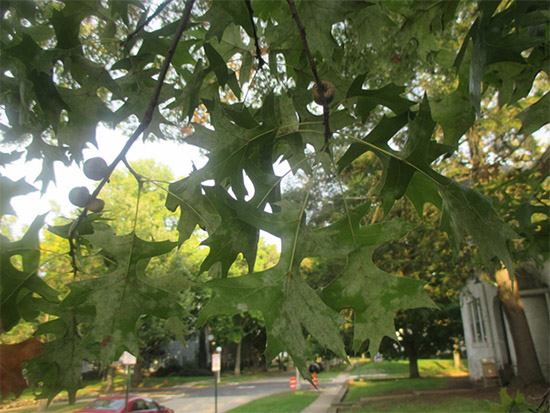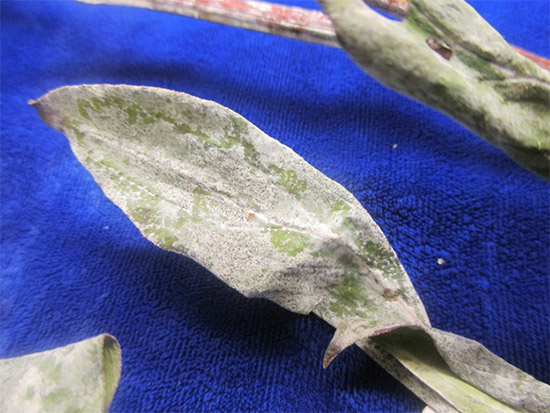Issue 16, October 6, 2014
Powdery Mildews
The days are getting shorter, the nights cooler: that's right, fall is here! There are a number of diseases we tend to see in fall due to the cooler temperatures and the shortened length of daylight. One of these diseases is powdery mildew.
Powdery mildew is caused by a large number of related fungal pathogens. It is common on a wide variety of hosts, including ornamental plants (examples: peony, phlox, rose, zinnia, lilac), vegetables (examples: beans, cucurbits such as cucumber, pumpkin, and squash), woody trees and shrubs (examples: oak, crabapple, rhododendron), and turf grass. Each species of the pathogen affects a smaller subset of hosts.
The disease gets its name from the white, powder-like fungal mat that is formed on the surface of the leaves and, occasionally, on the stems of affected plants. The fungi damage the plants by penetrating plant cells and parasitizing them. The fungal mat produced across the surface of the leaves also reduces the amount of sunlight available to the plant cells, interrupting photosynthesis.

Red oak leaves with the characteristic white, powdery coating on the bottom of the leaves. Photo credit Diane Plewa.
Conidia (asexual) spores are formed during the spring and fall months. These spores are clear, oval- or barrel-shaped and are produced in long chains extending from the surface of the affected plant tissue. They are only visible under high magnification. Wind, rain, and insects move the conidia in the landscape. Conidia are produced continuously until environmental conditions trigger the production of the overwintering structures. As the disease progresses, fungal resting structures known as cleistothecia or chasmothecia containing sexual spores form; these are visible to the naked eye or under weak magnification. These structures are small, black balls, similar in appearance to tiny poppy seeds. Spores are protected within the sphere where they overwinter and, in spring, the ball cracks open and the spores are released. Powdery mildew fungi also overwinter as fungal mats within plant tissue; as the plant tissue begins to grow in spring, so do the fungi which initiates a new year of infection.

Peony leaf with white fungal mat and small, black cleistothecia (overwintering structures). Photo credit University of Illinois Plant Clinic.
Disease development is favored by repeated cycles of warm (80 degrees F), dry days with a relative humidity around 40 to 70 percent, and cool (60 degrees F), damp nights with a relative humidity of 90 to 99 percent. However, conidia can germinate and initiate infection under a wide range of environmental conditions (temperatures between 42 and 95 degrees F, relative humidity between 23 and 99 percent). Conidia can germinate, infect, and produce the next generation of conidia in as little as 3 to 4 days. This can lead to powdery mildew epidemics, especially in spring and, more frequently, in fall when the environmental conditions are ideal.
Powdery mildew is usually not considered an important disease in the landscape, except under certain conditions. If the plants are already stressed due to drought, pest pressures, or other unfavorable conditions, powdery mildew will exacerbate this problem. If environmental conditions favor disease development early in the season, the fungi may cause greater damage to the plant. Powdery mildew is a concern on highly susceptible varieties. Along with the white fungal mats on the surface of the plant, the fungi can also cause distortion of leaves and premature leaf drop, severely reducing the ornamental value of many plants.
Cultural management techniques are highly recommended to control powdery mildew. The disease is worst among plants grown in overcrowded, shaded conditions with poor air circulation. When planning new plantings, choose locations with well-drained soil and space plants appropriately. Avoid shaded locations for highly susceptible plants, including phlox, rose, and zinnia. Stressed plants are more susceptible to pathogens and pests, and less able to repair damage. Maintaining plant vigor by watering during periods of drought, mulching, fertilizing when appropriate, and removing dead or diseased plant tissue can reduce stress. Above-ground plant tissue of herbaceous perennials (stems and leaves) should be removed in late fall or winter, along with leaf litter from trees and woody shrubs.
Fungicide sprays are available. When applying, ensure thorough, even coverage across the entire plant, including the undersides of leaves. Fungicides should be applied when the disease is first noticed, and may need to be re-applied every 7-14 days to protect the new growth. Fungicides with the following active ingredients are recommended for powdery mildews: myclobutanil, potassium bicarbonate, propiconazole, sulfer, tebuconazole, thiophanate-methyl, and triforine. Because powdery mildew is caused by a number of different fungi, and because they affect a wide range of host plants, you will need to check the chemical label to ensure that the product is recommended for powdery mildew on the specific host you plan to treat. (Diane Plewa)
Author:
Diane Plewa